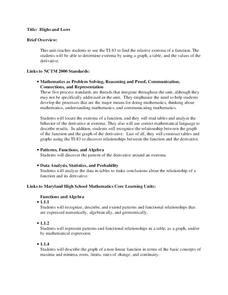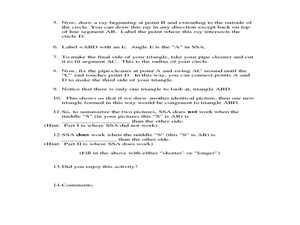EngageNY
Informal Proofs of Properties of Dilations
Challenge the class to prove that the dilation properties always hold. The lesson develops an informal proof of the properties of dilations through a discussion. Two of the proofs are verified with each class member performing the...
EngageNY
Converse of the Pythagorean Theorem
Discover a new application of the Pythagorean Theorem. Learners prove and apply the converse of the Pythagorean Theorem in the 17th lesson in a 25-part series. The examples ask learners to verify right triangles using the converse of the...
Curated OER
Pythagorean Theorem by Graphic Manipulation
There are many different ways to show a proof of the Pythagorean Theorem. Here is a nice hands-on paper cutting activity that shows a graphic representation. You can even challenge your young Pythagoreans to come up with their own...
Inside Mathematics
Magic Squares
Prompt scholars to complete a magic square using only variables. Then they can attempt to solve a numerical magic square using algebra.
Curated OER
Around the World With Geometry
Young scholars identify shapes, create shapes, and make a pyramid, a drum, and a sail using their shapes. In this shapes lesson plan, students also identify plane and space shapes.
Curated OER
Interactivate - Lines, Rays, Line Segments, and Planes
Young scholars explore lines, rays, line segments, and planes. For this math lesson, students discuss the math concepts and direct their instructor in graphing functions. Young scholars collaborate in graphing additional functions.
Shodor Education Foundation
Surface Area of Rectangular Prism
With this interactive lesson plan, learners compute the surface area of rectangular prisms. They visit an online investigation applet and record data on the provided handout. Pair this lesson plan with the volume lesson plan by the same...
Curated OER
Highs and Lows
Solve problems using integration and derivatives. By using calculus, learners will analyze graphs to find the extrema and change in behavior. They then will identify the end behavior using the derivatives. Activities and handouts are...
Curated OER
Why Doesn't SSA Work?
Students investigate the relationship between angles and their sides. In this geometry lesson, students prove why SSA does not work as a true angle side relationship theorem.
Curated OER
Fractals and the Chaos Game
High schoolers explore the concept of fractals. In this fractals lesson, students play the "Chaos Game" via an applet. High schoolers place dots on the screen to recognize that they have created Sierpinski's Triangle.
Curated OER
Determining Angle Measure with Parallel Lines
Young scholars observe and solve examples of corresponding angle postulates, alternate interior angle theorems, and exterior and consecutive angles. They complete the Determining Angle Measure With Parallel Lines worksheet.
Curated OER
Testing For Congruent Triangles
Students define and discuss congruency and the corresponding parts between congruent triangles. They create a pair of congruent triangles, test for congruency, and complete a worksheet.
Curated OER
Moving Straight Ahead
Students analyze the relationship between speed, time and distance. In this math lesson plan, students plan a school trip. Students determine the efficiency and cost effectiveness of a trip.
Curated OER
Irregular Fractals
High schoolers explore the concept of irregular fractals. In this irregular fractals lesson, students discuss how to find fractal dimensions through teacher led discussion. High schoolers calculate fractal dimensions of various fractals.















